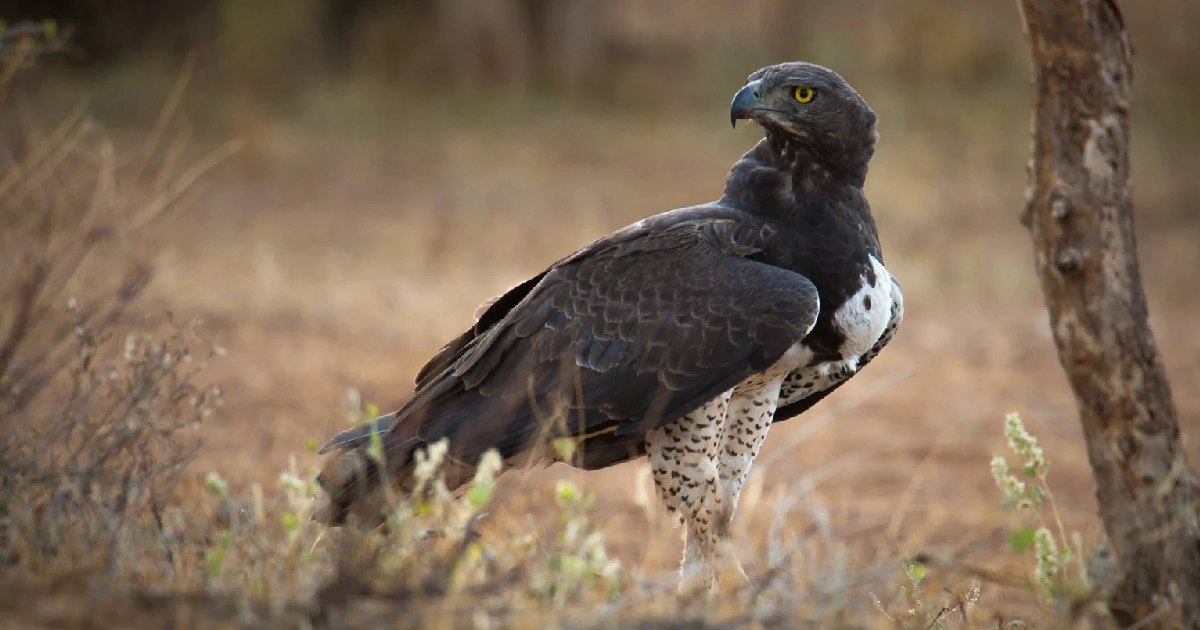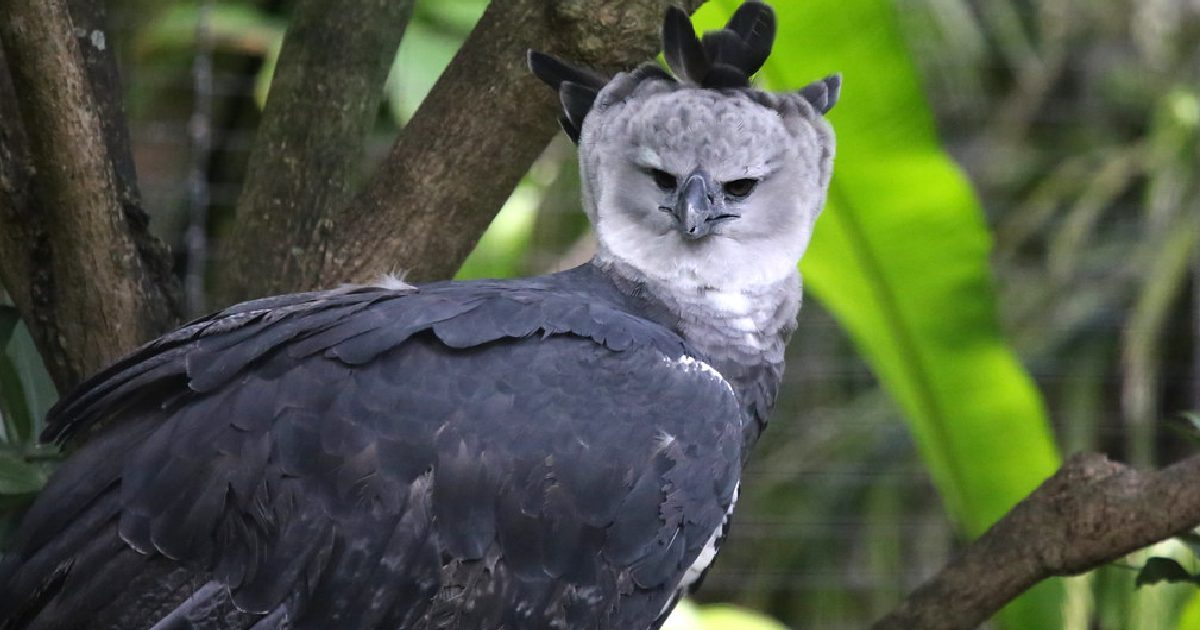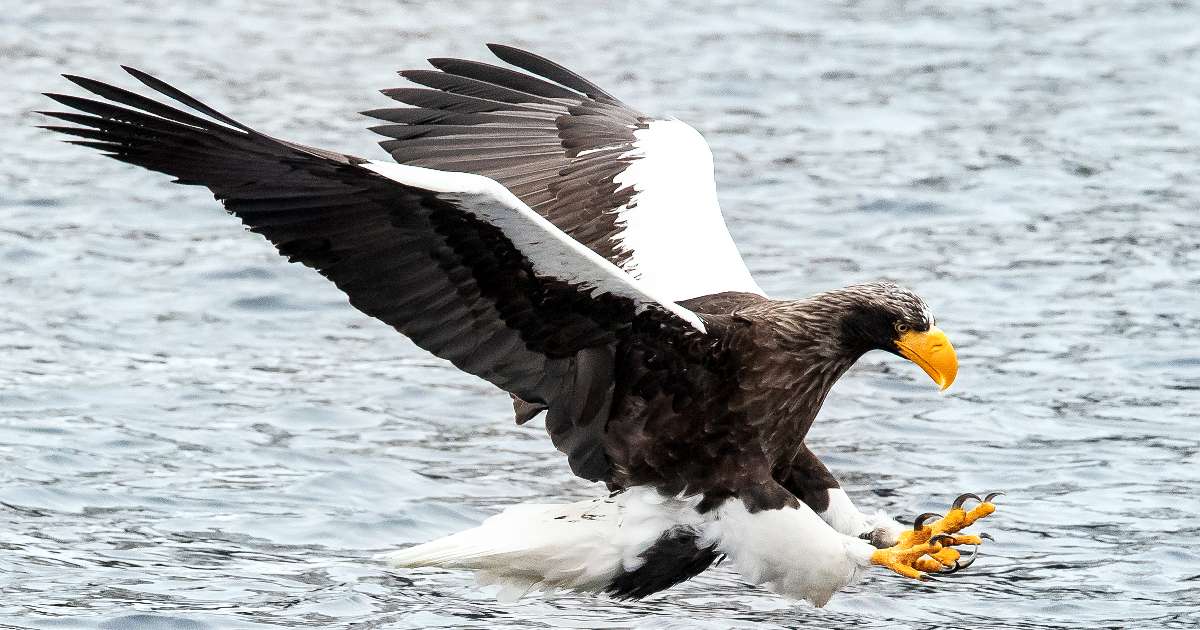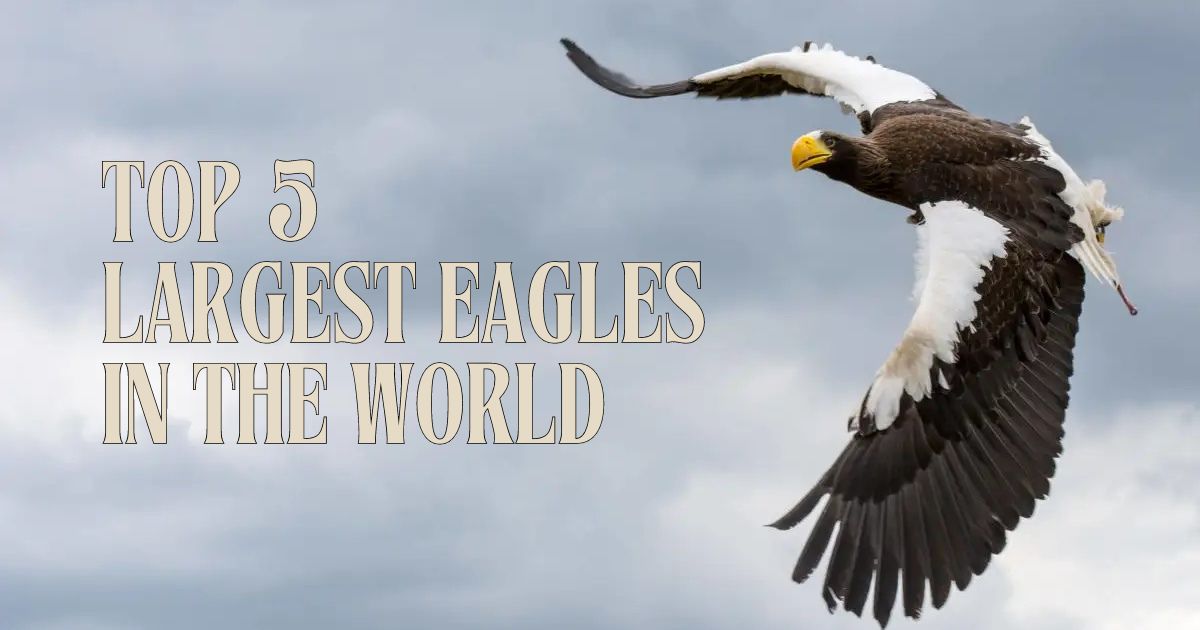When it comes to the bird kingdom, few sights are as breathtaking as an eagle soaring high with its immense wings spread wide. These majestic creatures embody power and grace, capturing the imagination of cultures worldwide. Among the largest eagles in the world, several species stand out due to their incredible wingspans, impressive weights, and formidable heights. This article delves into the fascinating details of these avian giants, exploring their physical characteristics, habitats, and unique features.
5. Martial Eagle

- Weight: 6.6 to 13.6 pounds (3 to 6.2 kilograms)
- Wingspan: Average wingspan 6 feet, 4 inches (1.9 meters) to over 8 feet (2.4 meters)
- Key Feature: Largest eagle in Africa, powerful talons
The Martial Eagle is the undisputed king of the African skies. This large eagle species is renowned for its strength and agility, making it a top predator in its habitat. The Martial Eagle’s wingspan can reach an impressive 8 feet, allowing it to glide effortlessly over the savannas and woodlands where it resides. With strikingly powerful talons, this bird of prey can tackle animals much larger than itself, including antelopes and other sizeable mammals.
This eagle’s plumage is predominantly dark brown, with a white underbelly speckled with dark spots. Its piercing yellow eyes give it a fierce appearance, befitting its status as a formidable hunter. The Martial Eagle’s diet is diverse, ranging from birds and reptiles to small mammals, which it captures with incredible precision and strength.
Conservation efforts are crucial for the Martial Eagle, as habitat destruction and human activities threaten its population. Despite these challenges, the Martial Eagle remains a symbol of the wild and untamed spirit of the African continent, soaring high above the land it has dominated for centuries.
4. White-tailed Eagle

- Weight: 6.8 to 15.2 pounds (3.1 to 6.9 kilograms)
- Wingspan: Up to 8 feet (2.4 meters)
- Key Feature: Also known as the white-tailed sea eagle, impressive fisher
The White-tailed Eagle, also known as the white-tailed sea eagle, is a magnificent bird that frequents coastal regions and large inland water bodies. Its wingspan can reach up to 8 feet, making it one of the largest eagles in the world. This bird’s striking appearance includes a white tail, yellow beak, and brown body, which distinguish it from other eagles.
White-tailed Eagles are expert fishers, often seen swooping down to snatch fish from the water’s surface with their powerful talons. Their diet also includes birds, small mammals, and carrion, showcasing their adaptability as hunters. These eagles build their nests high in trees or on cliffs, where they can keep a watchful eye over their territory.
Conservation efforts have been instrumental in the resurgence of White-tailed Eagle populations, particularly in regions where they were once near extinction. The success of these efforts is a testament to the resilience of this majestic bird and the importance of preserving their natural habitats for future generations.
3. Philippine Eagle

- Weight: 10 to 18 pounds (4.5 to 8.2 kilograms)
- Wingspan: 6 feet, 6 inches (2 meters)
- Key Feature: National bird of the Philippines, critically endangered
The Philippine Eagle, the national bird of the Philippines, is a symbol of strength and beauty. This critically endangered species boasts a wingspan of 6 feet, 6 inches and a weight that can reach up to 18 pounds, making it one of the largest eagles in the world. Its distinctive appearance includes a striking crest of long, brown feathers that frame its face, giving it a regal and imposing look.
Philippine Eagles are forest dwellers, residing in the dense tropical rainforests of the Philippines. They primarily prey on mammals, birds, and reptiles, showcasing their versatility as hunters. Unfortunately, deforestation and human activities have severely impacted their population, leaving only around 500 individuals in the wild. Conservation programs are crucial to protect this iconic species and its habitat.
A Philippine eagle pair forms a strong bond, often mating for life. They build their nests high in the trees, where they can safely raise their young. The Philippine Eagle’s majestic presence and critical conservation status have made it a symbol of wildlife protection efforts in the Philippines, highlighting the need to preserve the natural world.
2. Harpy Eagle

- Weight: Males: 9 to 11 pounds (4.1 to 4.99 kilograms); Females: 13 to 20 pounds (5.9 to 9.1 kilograms)
- Wingspan: 6 feet, 6 inches (2 meters)
- Key Feature: Powerful legs and talons, rainforest dweller
The Harpy Eagle, with its formidable size and strength, is one of the most powerful raptors in the world. Male harpy eagles weigh between 9 and 11 pounds, while females are significantly larger, weighing between 13 and 20 pounds. The harpy eagle wingspan is equally impressive, measuring around 6 feet, 6 inches. This eagle’s powerful legs and talons are capable of exerting immense force, enabling it to capture large prey with ease.
Harpy Eagles inhabit the rainforests of Central and South America, where they hunt a variety of animals, including monkeys and sloths. Their distinctive appearance includes a crown of feathers that stands erect when they are alert, adding to their imposing presence. The Harpy Eagle’s keen eyesight allows it to spot prey from great distances, making it a top predator in its environment.
Conservation efforts are critical for the Harpy Eagle, as habitat destruction poses a significant threat to its survival. These eagles play a vital role in maintaining the balance of their ecosystem, and protecting them is essential for preserving the biodiversity of the rainforests they call home.
1. Steller’s Sea Eagle

- Weight: 11 to 20 pounds (5 to 9 kilograms)
- Wingspan: Up to 8 feet (2.4 meters)
- Key Feature: Largest eagle by weight, striking appearance
The Steller’s Sea Eagle is the heaviest and one of the most visually striking eagles in the world. With a wingspan of up to 8 feet and a weight ranging from 11 to 20 pounds, this eagle commands attention. Its distinctive black and white plumage, combined with a bright yellow beak and talons, makes it easily recognizable.
Native to the coastal regions of northeastern Asia, particularly Russia and Japan, Steller’s Sea Eagles primarily feed on fish and waterfowl. Their powerful build and sharp talons enable them to catch and hold onto slippery prey. These eagles are known for their impressive hunting skills and often perch on ice floes or coastal cliffs as they survey their surroundings.
The Steller’s Sea Eagle’s impressive size and striking appearance have made it a subject of fascination and admiration. However, like many large eagle species, it faces threats from habitat loss and environmental changes. Conservation efforts are essential to ensure the survival of this magnificent bird, preserving its place as one of the world’s largest and most awe-inspiring eagles.
Conclusion
The largest eagles in the world are truly remarkable creatures, each possessing unique characteristics that make them stand out. From the powerful Martial Eagle of Africa, the Bald Eagle, to the critically endangered Philippine Eagle, these birds of prey embody the spirit of the wild and the delicate balance of nature. Understanding and protecting these majestic eagles, including those not mentioned, such as male bald eagles and wedge-tailed eagle, is crucial for maintaining biodiversity and ensuring that future generations can marvel at their beauty and strength. By appreciating these incredible birds and supporting conservation efforts, we can help preserve their habitats and secure their future in the natural world.
Frequently Asked Questions (FAQs)
What is the largest predator eagle in the world?
The largest predator eagle in the world is the Steller’s Sea Eagle. Recognized for its impressive size and strength, the Steller’s Sea Eagle weighs between 11 to 20 pounds (5 to 9 kilograms) and boasts a wingspan of up to 8 feet (2.4 meters). This massive bird of prey primarily inhabits coastal regions in northeastern Asia, where it feeds on fish and other marine animals.
Is the Philippine eagle bigger than the American eagle?
Yes, the Philippine Eagle is generally larger than the American Bald Eagle. The Philippine Eagle, also known as the monkey-eating eagle, can weigh between 10 to 18 pounds (4.5 to 8.2 kilograms) with a wingspan reaching up to 7.2 feet (2.2 meters). In contrast, the Bald Eagle has a wingspan of 5.5 to 8 feet (1.68 to 2.4 meters) and weighs between 6.6 to 14 pounds (3 to 6.3 kilograms).
Are golden eagles bigger than bald eagles?
Golden Eagles are not necessarily bigger than Bald Eagles, but they are comparable in size. Golden Eagles have a wingspan of 6 to 7.5 feet (1.8 to 2.3 meters) and weigh between 6.6 to 15 pounds (3 to 6.8 kilograms). Bald Eagles have a similar wingspan, ranging from 5.5 to 8 feet (1.68 to 2.4 meters), and weigh between 6.6 to 14 pounds (3 to 6.3 kilograms). The sizes of these eagles often overlap.
How big is the giant golden eagle?
The term “giant golden eagle” typically refers to the largest specimens of the Golden Eagle species. These magnificent birds can have a wingspan stretching up to 7.5 feet (2.3 meters) and weigh between 6.6 to 15 pounds (3 to 6.8 kilograms). Known for their powerful build and impressive hunting prowess, Golden Eagles are one of the largest and most formidable birds of prey.
What is the largest eagle ever recorded?
The largest eagle ever recorded is the Haast’s Eagle (Hieraaetus moorei), now extinct, which once lived in New Zealand. It weighed up to 33 pounds (15 kilograms) and had a wingspan of up to 10 feet (3 meters). Among living eagles, the Steller’s Sea Eagle holds the title, weighing between 11 to 20 pounds (5 to 9 kilograms) with a wingspan of 8 feet (2.4 meters).

